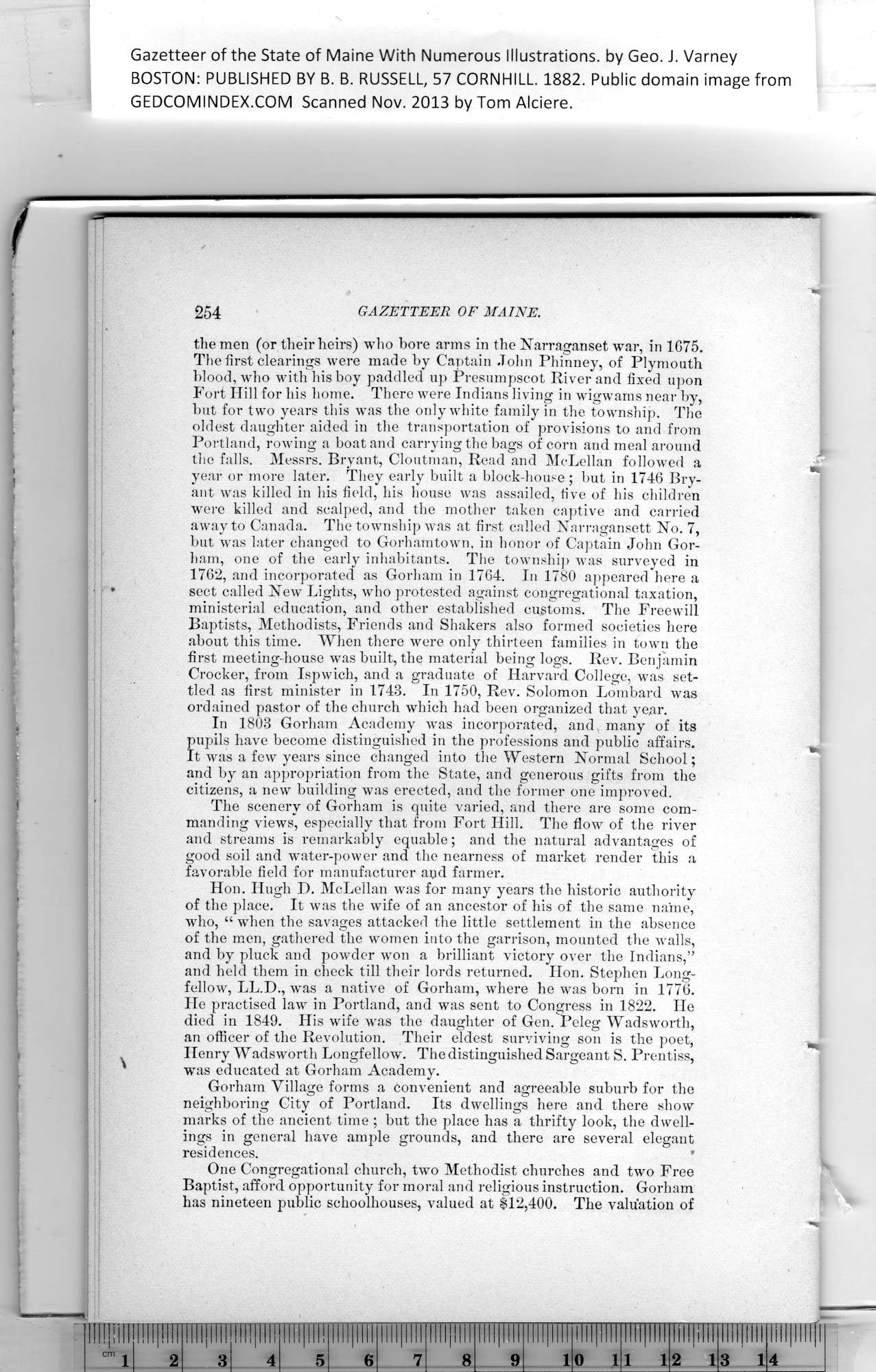|
Gazetteer of the State of Maine With Numerous Illustrations, by Geo. J. Varney
BOSTON: PUBLISHED BY B. B. RUSSELL, 57 CORNHILL. 1882. Public domain image from
254 GAZETTEER OF MAINE.
the men (or their heirs) who bore arms in the Narraganset war, in 1675.
The first clearings were made by Captain John Phinney, of Plymouth
blood, who with his boy paddled up Presumpscot River and fixed upon
Fort Hill for his home. There were Indians living in wigwams near by,
but for two years this was the only white family in the township. The
oldest daughter aided in the transportation of provisions to and from
Portland, rowing a boat and carrying the bags of corn and meal around
the falls. Messrs. Bryant, Cloutman, Read and McLellan followed a
year or more later. They early built a block-house ; but in 1746 Brv-
ant was killed in his field, his house was assailed, five of his children
were killed and scalped, and the mother taken captive and carried
away to Canada. The township was at first called Narragansett No. 7,
but was later changed to Gorhamtown, in honor of Captain John Gor-
ham, one of the early inhabitants. The township was surveyed in
1762, and incorporated as Gorham in 1764. In 1780 appeared here a
sect called New Lights, who protested against congregational taxation,
ministerial education, and other established customs. The Freewill
Baptists, Methodists, Friends and Shakers also formed societies here
about this time. When there were only thirteen families in town the
first meeting-house was built, the material being logs. Rev. Benjamin
Crocker, from Ispwich, and a graduate of Harvard College, was set-
tled as first minister in 1743. In 1750, Rev. Solomon Lombard was
ordained pastor of the church which had been organized that year.
In 1803 Gorham Academy was incorporated, and many of its
pupils have become distinguished in the professions and public affairs.
It was a few years since changed into the Western Normal School;
and by an appropriation from the State, and generous gifts from the
citizens, a new building was erected, and the former one improved.
The scenery of Gorham is quite varied, and there are some com-
manding views, especially that from Fort Hill. The flow of the river
and streams is remarkably equable; and the natural advantages of
good soil and water-power and the nearness of market render this a
favorable field for manufacturer and farmer.
Hon. Hugh D. McLellan was for many years the historic authority
of the place. It was the wife of an ancestor of his of the same name,
wTho, “ when the savages attacked the little settlement in the absence
of the men, gathered the women into the garrison, mounted the walls,
and by pluck and powder won a brilliant victory over the Indians,”
and held them in check till their lords returned. Hon. Stephen Long-
fellow, LL.D., was a native of Gorham, where he was born in 1776.
He practised law in Portland, and was sent to Congress in 1822. He
died in 1849. His wife was the daughter of Gen. Peleg Wadsworth,
an officer of the Revolution. Their eldest surviving son is the poet,
Henry Wadsworth Longfellow. The distinguished Sargeant S. Prentiss,
was educated at Gorham Academy.
Gorham Village forms a convenient and agreeable suburb for the
neighboring City of Portland. Its dwellings here and there show
marks of the ancient time ; but the place has a thrifty look, the dwell-
ings in general have ample grounds, and there are several elegant
residences. *
One Congregational church, two Methodist churches and two Free
Baptist, afford opportunity for moral and religious instruction. Gorham
has nineteen public schoolhouses, valued at $12,400. The valuation of
PREVIOUS PAGE ... NEXT PAGE
This page was written in HTML using a program written in Python 3.2
|
